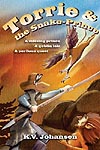
Torrie and the Snake-Prince |
|
Wren's Bannock When I went adventuring with Wren, we ate a lot of bannock. When you live a travelling life, like Wren, you don't want to carry a pot of bubbling yeast along with you, so you make bread like this. It makes a heavy sort of bread or cake, of course, because of not having any yeast to make it nice and light. But you can't go adventuring without some inconvenience. Bannock is quite tasty when it's warm, and you can always dip it in your soup or your tea if you find it too dry. In High Morroway, of course, you should always eat it with cheese. Or sometimes duck eggs. Mix together one and a half cups of oatmeal, a cup of flour, and a pinch or two of salt. (By oatmeal, I mean real oatmeal: ground-up oats, not flakes of oats rolled out flat. If you are live near an old-fashioned grist mill, it should be easy to get real oatmeal. Otherwise, you might have to look a bit harder, but you should still be able to find it somewhere. One world I know of calls it "Scotch oatmeal", after a country where bannocks are so important that they once had a battle because some king burnt one. Or I think that's how the story went. Was there a spider in it, as well? Perhaps I'm getting several stories mixed up. Yes, now that I think of it, I am. The cake-burning king was from a different country entirely. But really, I have enough to do keeping track of my own tales. If you're desperate, use rolled oats. It will probably taste good anyway.) Using your fingers (make sure your hands are clean, because even though everyone has to eat their peck of dirt in a lifetime, it shouldn't be all at once), rub in a generous third of a cup of butter. Then stir in about a third of a cup of boiling water. Knead the dough a little. It should be quite stiff, not sticky. If it's too dry, add more water; if it's too wet, add more flour. You can cook it on a flat clean stone by the fire, but a cast-iron griddle works well, or a frying pan. Knights in later centuries sometimes used their shields, but since in Wren's day shields were made of wood, this would have been a bad idea. Anyway, she didn't have a shield. Rub the pan with a little grease. Then take a ball of enough dough to hold in the palm of your hand, and press it out flat, using the palms of your hands and your fingers. It shouldn't be any thicker than half an inch at most. Make as many as will fit on your rock or pan, and cook them. You can lift them up with a knife or a spatula to see how they're doing. They'll get brown patches. You probably don't want them to get burnt, but a little blackened in spots is fine. Turn them over and cook the other side. Depending on how big your pan (or rock) is, you'll have to cook them in several batches. This should make enough to feed you and two friends, with maybe some left over for breakfast, unless the goblin is particularly hungry. Bannock is very filling. Best with butter, jam, honey, and High Morrowaian cheese, the kind with holes. Another kind of oatcake that is very good for taking on adventures is just called oatcake. It is drier than Wren's bannock, and is like a thin, crispy biscuit. In one world I know, you can find a very good recipe for these in a book called Out of Old Nova Scotia Kitchens, or even buy them ready-made in shops, where they are called Scotch Oatcakes.
If you can read Macedonian, Wren's Bannock recipe has been translated by the translator of Torrie and the Snake-Prince (Тори и принцот-змија in Macedonian): Лепчето на Палче - бенок © 2008 K.V. Johansen www.pippin.ca |
|
